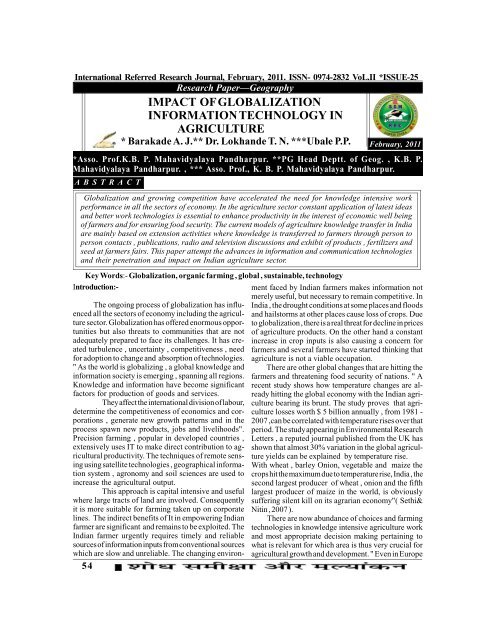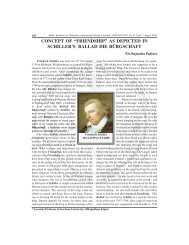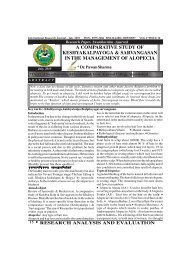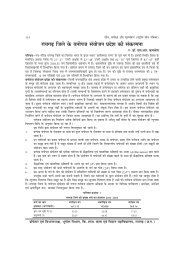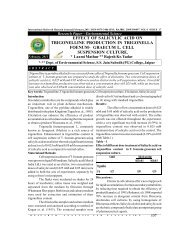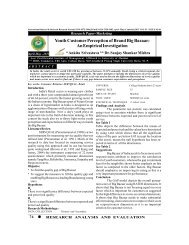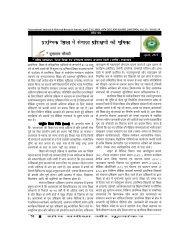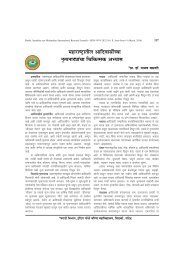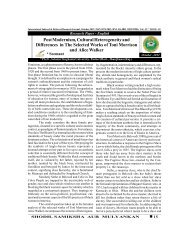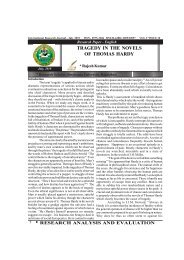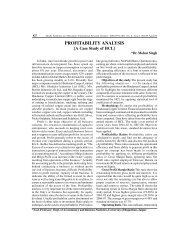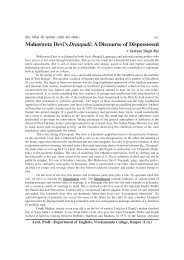impact of globalization information technology in agriculture
impact of globalization information technology in agriculture
impact of globalization information technology in agriculture
Create successful ePaper yourself
Turn your PDF publications into a flip-book with our unique Google optimized e-Paper software.
*** Assot. *-** Pr<strong>of</strong>. Assot. & UG Pr<strong>of</strong>. & PG Dept. H.O.D.Geography, <strong>of</strong> , K.B. K.B. P. P. Mahavidyalaya , Pandharpur.<br />
M.S.<br />
International Referred Research Journal, February, 2011. ISSN- 0974-2832 VoL.II *ISSUE-25<br />
Research Paper—Geography<br />
A B S T R A C T<br />
Key Words:- Globalization, organic farm<strong>in</strong>g , global , susta<strong>in</strong>able, <strong>technology</strong><br />
Introduction:-<br />
The ongo<strong>in</strong>g process <strong>of</strong> <strong>globalization</strong> has <strong>in</strong>fluenced<br />
all the sectors <strong>of</strong> economy <strong>in</strong>clud<strong>in</strong>g the <strong>agriculture</strong><br />
sector. Globalization has <strong>of</strong>fered enormous opportunities<br />
but also threats to communities that are not<br />
adequately prepared to face its challenges. It has created<br />
turbulence , uncerta<strong>in</strong>ty , competitiveness , need<br />
for adoption to change and absorption <strong>of</strong> technologies.<br />
" As the world is globaliz<strong>in</strong>g , a global knowledge and<br />
<strong><strong>in</strong>formation</strong> society is emerg<strong>in</strong>g , spann<strong>in</strong>g all regions.<br />
Knowledge and <strong><strong>in</strong>formation</strong> have become significant<br />
factors for production <strong>of</strong> goods and services.<br />
They affect the <strong>in</strong>ternational division <strong>of</strong> labour,<br />
determ<strong>in</strong>e the competitiveness <strong>of</strong> economics and corporations<br />
, generate new growth patterns and <strong>in</strong> the<br />
process spawn new products, jobs and livelihoods".<br />
Precision farm<strong>in</strong>g , popular <strong>in</strong> developed countries ,<br />
extensively uses IT to make direct contribution to agricultural<br />
productivity. The techniques <strong>of</strong> remote sens<strong>in</strong>g<br />
us<strong>in</strong>g satellite technologies , geographical <strong><strong>in</strong>formation</strong><br />
system , agronomy and soil sciences are used to<br />
<strong>in</strong>crease the agricultural output.<br />
This approach is capital <strong>in</strong>tensive and useful<br />
where large tracts <strong>of</strong> land are <strong>in</strong>volved. Consequently<br />
it is more suitable for farm<strong>in</strong>g taken up on corporate<br />
l<strong>in</strong>es. The <strong>in</strong>direct benefits <strong>of</strong> It <strong>in</strong> empower<strong>in</strong>g Indian<br />
farmer are significant and rema<strong>in</strong>s to be exploited. The<br />
Indian farmer urgently requires timely and reliable<br />
sources <strong>of</strong> <strong><strong>in</strong>formation</strong> <strong>in</strong>puts from conventional sources<br />
which are slow and unreliable. The chang<strong>in</strong>g environ-<br />
54<br />
IMPACT OF GLOBALIZATION<br />
INFORMATIONTECHNOLOGY IN<br />
AGRICULTURE<br />
* Barakade A. J.** Dr. Lokhande T. N. ***Ubale P.P.<br />
February, 2011<br />
*Asso. Pr<strong>of</strong>.K.B. P. Mahavidyalaya Pandharpur. **PG Head Deptt. <strong>of</strong> Geog. , K.B. P.<br />
Mahavidyalaya Pandharpur. , *** Asso. Pr<strong>of</strong>., K. B. P. Mahavidyalaya Pandharpur.<br />
Globalization and grow<strong>in</strong>g competition have accelerated the need for knowledge <strong>in</strong>tensive work<br />
performance <strong>in</strong> all the sectors <strong>of</strong> economy. In the <strong>agriculture</strong> sector constant application <strong>of</strong> latest ideas<br />
and better work technologies is essential to enhance productivity <strong>in</strong> the <strong>in</strong>terest <strong>of</strong> economic well be<strong>in</strong>g<br />
<strong>of</strong> farmers and for ensur<strong>in</strong>g food security. The current models <strong>of</strong> <strong>agriculture</strong> knowledge transfer <strong>in</strong> India<br />
are ma<strong>in</strong>ly based on extension activities where knowledge is transferred to farmers through person to<br />
person contacts , publications, radio and television discussions and exhibit <strong>of</strong> products , fertilizers and<br />
seed at farmers fairs. This paper attempt the advances <strong>in</strong> <strong><strong>in</strong>formation</strong> and communication technologies<br />
and their penetration and <strong>impact</strong> on Indian <strong>agriculture</strong> sector.<br />
ment faced by Indian farmers makes <strong><strong>in</strong>formation</strong> not<br />
merely useful, but necessary to rema<strong>in</strong> competitive. In<br />
India , the drought conditions at some places and floods<br />
and hailstorms at other places cause loss <strong>of</strong> crops. Due<br />
to <strong>globalization</strong> , there is a real threat for decl<strong>in</strong>e <strong>in</strong> prices<br />
<strong>of</strong> <strong>agriculture</strong> products. On the other hand a constant<br />
<strong>in</strong>crease <strong>in</strong> crop <strong>in</strong>puts is also caus<strong>in</strong>g a concern for<br />
farmers and several farmers have started th<strong>in</strong>k<strong>in</strong>g that<br />
<strong>agriculture</strong> is not a viable occupation.<br />
There are other global changes that are hitt<strong>in</strong>g the<br />
farmers and threaten<strong>in</strong>g food security <strong>of</strong> nations. " A<br />
recent study shows how temperature changes are already<br />
hitt<strong>in</strong>g the global economy with the Indian <strong>agriculture</strong><br />
bear<strong>in</strong>g its brunt. The study proves that <strong>agriculture</strong><br />
losses worth $ 5 billion annually , from 1981 -<br />
2007 ,can be correlated with temperature rises over that<br />
period. The study appear<strong>in</strong>g <strong>in</strong> Environmental Research<br />
Letters , a reputed journal published from the UK has<br />
shown that almost 30% variation <strong>in</strong> the global <strong>agriculture</strong><br />
yields can be expla<strong>in</strong>ed by temperature rise.<br />
With wheat , barley Onion, vegetable and maize the<br />
crops hit the maximum due to temperature rise, India , the<br />
second largest producer <strong>of</strong> wheat , onion and the fifth<br />
largest producer <strong>of</strong> maize <strong>in</strong> the world, is obviously<br />
suffer<strong>in</strong>g silent kill on its agrarian economy"( Sethi&<br />
Nit<strong>in</strong> , 2007 ).<br />
There are now abundance <strong>of</strong> choices and farm<strong>in</strong>g<br />
technologies <strong>in</strong> knowledge <strong>in</strong>tensive <strong>agriculture</strong> work<br />
and most appropriate decision mak<strong>in</strong>g perta<strong>in</strong><strong>in</strong>g to<br />
what is relevant for which area is thus very crucial for<br />
agricultural growth and development. " Even <strong>in</strong> Europe
International Referred Research Journal, February, 2011. ISSN- 0974-2832 VoL.II *ISSUE-25<br />
, reportedly more likely to be found <strong>in</strong> disadvantaged<br />
areas , or areas unfavourable for conventional agricultural<br />
production" .Abundance <strong>of</strong> knowledge <strong>in</strong> the field<br />
<strong>of</strong> <strong>agriculture</strong> has accumulated out <strong>of</strong> outcomes and<br />
experiences <strong>of</strong> various farm<strong>in</strong>g practices <strong>in</strong> various parts<br />
<strong>of</strong> the world. " For <strong>in</strong>stance , farmers <strong>in</strong> Southern Sudan<br />
and Zaire noticed that the sites <strong>of</strong> termite moulds are<br />
particularly good for grow<strong>in</strong>g sorghum and cowpea.<br />
Farmers <strong>in</strong> Zaachilla , Mexico use ant refuse to<br />
fertilize high value crops such as tomatoes, chili and<br />
onions" ( Reijnties,C and Haverkort and A. Water -<br />
Bayer , 1992 ).<br />
Objectives:-<br />
The major object <strong>of</strong> this paper is to asses the .,<br />
1.To study the <strong>impact</strong> <strong>of</strong> <strong>globalization</strong> on India.<br />
2.To study the knowledge transfer to Indian farmers.<br />
Study area :-<br />
The present study deals with the geographical<br />
perspectives <strong>of</strong> the <strong>impact</strong> <strong>of</strong> <strong>globalization</strong> <strong><strong>in</strong>formation</strong><br />
<strong>technology</strong> <strong>in</strong> <strong>agriculture</strong> <strong>in</strong> India.<br />
Database and Methodology:-<br />
Present study mostly relies on the secondary<br />
data collected through agricultural department, Agricultural<br />
statistical <strong>in</strong> India, Directorate <strong>of</strong> economics<br />
and statistics Krishi Bhavan New Delhi. Government <strong>of</strong><br />
India National knowledge commission, Report, Globalization<br />
and poverty.<br />
Impact <strong>of</strong> Globalization on India:-<br />
As far as agricultural development is concerned<br />
India is a unique country among the develop<strong>in</strong>g world.<br />
The most advanced as well as the most primitive k<strong>in</strong>d<br />
<strong>of</strong> agricultural technologies are practiced <strong>in</strong> the country.<br />
On one hand there are most modern agricultural<br />
implements such as tractors and harvest<strong>in</strong>g comb<strong>in</strong>es,<br />
on the other hand there are millions <strong>of</strong> farmers us<strong>in</strong>g<br />
bullock carts and ploughs. There are like <strong>in</strong> Konkan<br />
where it ra<strong>in</strong>s all the time and there are places <strong>in</strong> Solapur<br />
, eastern part <strong>of</strong> the Satara district , some part <strong>of</strong> the<br />
Sangli district which <strong>of</strong>ten witness drought conditions.<br />
Diversity <strong>of</strong> soil and climatic conditions are exist<strong>in</strong>g <strong>in</strong><br />
the country and hence India is known for diversity <strong>of</strong><br />
plant species and varieties <strong>of</strong> crops.<br />
The country has diverse geographical sett<strong>in</strong>g<br />
such as hilly terra<strong>in</strong>s , wet lands , valleys, desert and<br />
sea coast. A variety <strong>of</strong> crops can thus be grown and<br />
various agricultural technologies can be adopted and<br />
adapted to specific needs . There are farmers who have<br />
developed hundreds <strong>of</strong> web pages <strong>of</strong> <strong>agriculture</strong> <strong><strong>in</strong>formation</strong><br />
and communicate through email and there are<br />
also the farmers who still dispatch their messages<br />
through pigeon carries. There are hundreds <strong>of</strong> language<br />
spoken and several ethnic groups <strong>of</strong> farmers liv<strong>in</strong>g <strong>in</strong><br />
various cultural sett<strong>in</strong>g and hav<strong>in</strong>g different belief and<br />
ethical systems.<br />
The major problems <strong>of</strong> Indian <strong>agriculture</strong> are fragmented<br />
farms , monsoon dependent irrigation <strong>in</strong> several<br />
areas, disrupted power supply, <strong>in</strong>creas<strong>in</strong>g cost <strong>of</strong> farm<br />
<strong>in</strong>puts, non-availability <strong>of</strong> <strong>in</strong>ternational quality seeds<br />
, exploitation <strong>of</strong> poor and illiterate farmers by <strong>in</strong>termediaries<br />
and lend<strong>in</strong>g <strong>in</strong>stitutions , lack <strong>of</strong> adequate <strong><strong>in</strong>formation</strong><br />
perta<strong>in</strong><strong>in</strong>g to what can be most useful and relevant<br />
<strong>in</strong> a given area and situation.<br />
There is enormous fluctuation <strong>in</strong> the prices <strong>of</strong> agricultural<br />
commodities. The prices <strong>of</strong> onions may be Rs.<br />
5/ -when the farmers sell it but may <strong>in</strong>crease five times<br />
up to Rs. 50/- when sold <strong>in</strong> retail market at a different time<br />
and such price hikes not only affect the farmers but<br />
severely affect the pocket <strong>of</strong> common man and polity <strong>of</strong><br />
the nation. The <strong>in</strong>creas<strong>in</strong>g cost <strong>of</strong> agricultural <strong>in</strong>puts<br />
and comparatively low cost <strong>of</strong> agricultural products <strong>in</strong><br />
the <strong>in</strong>ternational market is creat<strong>in</strong>g a crises situation for<br />
Indian <strong>agriculture</strong>.<br />
In India 70 percent <strong>of</strong> farmers are cultivators <strong>of</strong><br />
small plots from which they can hardly get food security<br />
let alone susta<strong>in</strong>able <strong>in</strong>comes. Most <strong>of</strong> them are small<br />
and marg<strong>in</strong>al farmers cultivat<strong>in</strong>g land less than one<br />
hectare <strong>in</strong> size, average size <strong>of</strong> which decreases by half<br />
every 15 years due to rapid population growth. Today<br />
nearly 60 percent <strong>of</strong> farmers belong to marg<strong>in</strong>al category<br />
with an average <strong>of</strong> 0.4 ha. Land. Small land hold<strong>in</strong>gs,<br />
grow<strong>in</strong>g cost <strong>of</strong> production , <strong>in</strong>creas<strong>in</strong>g debt, low<br />
prices <strong>of</strong> some agricultural commodities <strong>in</strong> the <strong>in</strong>ternational<br />
market is aggravat<strong>in</strong>g the problems <strong>of</strong> small farmers<br />
and lead<strong>in</strong>g to some suicides . Hundreds <strong>of</strong> farmers<br />
Maharashtra Sate <strong>in</strong> the Vidarbha region have committed<br />
suicides and such <strong>in</strong>cidences have also been reported<br />
from other parts <strong>of</strong> India.<br />
Progressive farmers from India are gett<strong>in</strong>g exposure<br />
to best possible available technologies and educated<br />
young- men work<strong>in</strong>g <strong>in</strong> International <strong>agriculture</strong><br />
related companies are help<strong>in</strong>g <strong>in</strong> diffusion <strong>of</strong> better<br />
<strong>agriculture</strong> technologies <strong>in</strong> their geographical areas. "<br />
Globalization <strong>in</strong> the context <strong>of</strong> <strong>agriculture</strong> can best be<br />
discussed <strong>in</strong> the context <strong>of</strong> three components - improvements<br />
<strong>of</strong> productive efficiency by ensur<strong>in</strong>g the<br />
convergence <strong>of</strong> potential and realized outputs, <strong>in</strong>crease<br />
<strong>in</strong> agricultural exports and value added activities us<strong>in</strong>g<br />
agricultural produce , and f<strong>in</strong>ally improved access to<br />
domestic and <strong>in</strong>ternational markets that are either tightly<br />
regulated or overly protected" Mahadevan , Renuka,<br />
2003). To facilitate second Green revolution <strong>in</strong> India , a<br />
massive effort for tra<strong>in</strong><strong>in</strong>g <strong>of</strong> farmers is required. Merely<br />
transfer <strong>of</strong> <strong><strong>in</strong>formation</strong> to farmers is not sufficient by<br />
itself. Farmers themselves must be able to make choices<br />
what is best for them and thoroughly understand what<br />
to do and how to do enhance their <strong>agriculture</strong> productivity<br />
and improve their economic lot. World's best<br />
available <strong>agriculture</strong> knowledge must be available to<br />
S H O D H S A M I K S H A A U R M U L Y A N K A N 55
International Referred Research Journal, February, 2011. ISSN- 0974-2832 VoL.II *ISSUE-25<br />
Indian farmers and they must be motivated to use it <strong>in</strong> India has a good <strong>in</strong>stitutional <strong>in</strong>frastructure . The<br />
their best <strong>in</strong>terest. Necessary motivation to use the agricultural Universities and research <strong>in</strong>stitutes helped<br />
latest ideas <strong>in</strong> agricultural practices is possibly only if <strong>in</strong> ' Green Revolution' , White Revolution' , and 'Blue<br />
it serves the farmers' <strong>in</strong>terests <strong>agriculture</strong> development Revolution'. Some <strong>in</strong>stitutes are also help<strong>in</strong>g <strong>in</strong> develop<strong>in</strong>g<br />
technologies for ICT development <strong>in</strong> rural areas<br />
and small farmers ' economic advancement must go<br />
hand <strong>in</strong> hand.<br />
and improv<strong>in</strong>g national <strong><strong>in</strong>formation</strong> <strong>in</strong>frastructure.<br />
It is not difficult to conv<strong>in</strong>ce farmers for a good Now a number <strong>of</strong> educated to farmers also<br />
cause provided concerted efforts are made and <strong><strong>in</strong>formation</strong><br />
technologies are adequately used to show how to such as farm<strong>in</strong>g practices , weather reports and prices<br />
provide beneficial and useful <strong><strong>in</strong>formation</strong> to farmers<br />
do the th<strong>in</strong>gs and expla<strong>in</strong> what are the possible benefits <strong>of</strong> <strong>agriculture</strong> crop products <strong>in</strong> various markets , and<br />
<strong>in</strong>stead <strong>of</strong> merely transferr<strong>in</strong>g the know- how. Farmers transfer other desired <strong>agriculture</strong> knowledge <strong>in</strong> local<br />
should also make <strong>in</strong>creas<strong>in</strong>g efforts for learn<strong>in</strong>g new language through expert panelists, advice. The ITC<br />
technologies and become <strong><strong>in</strong>formation</strong> literate for surviv<strong>in</strong>g<br />
and thriv<strong>in</strong>g the knowledge <strong>in</strong>tensive farm<strong>in</strong>g ment <strong>of</strong> produce and sell<strong>in</strong>g products to farmers.<br />
also use this network for its own bus<strong>in</strong>ess <strong>of</strong> procure-<br />
area. For constant access to latest <strong>agriculture</strong> knowledge<br />
someone from the farmer family must have access Though enormous <strong>in</strong>itiatives have been taken<br />
Knowledge Transfer to Indian Farmers:-<br />
to the Internet facilities , knowledge <strong>of</strong> us<strong>in</strong>g the electronic<br />
<strong><strong>in</strong>formation</strong> resources and be competent enough ture for knowledge to Indian farm<strong>in</strong>g communities , yet<br />
and are be<strong>in</strong>g undertaken to develop rural <strong>in</strong>frastruc-<br />
to make effective use <strong>of</strong> <strong><strong>in</strong>formation</strong> technologies. these are not adequate enough keep<strong>in</strong>g <strong>in</strong> view the<br />
Efforts are be<strong>in</strong>g made at various levels to number <strong>of</strong> Indian farmers, complexity <strong>of</strong> their problems<br />
improve the <strong><strong>in</strong>formation</strong> communication <strong>in</strong>frastructure and impediments <strong>in</strong> successful implementation <strong>of</strong> plans<br />
<strong>in</strong> India. There is consistent growth <strong>of</strong> mobile telephony that may ultimately ensure access to need based knowledge<br />
resources for every farmers. There are more than<br />
<strong>in</strong> India. Because <strong>of</strong> fierce price competition , mobile<br />
telephony is becom<strong>in</strong>g one <strong>of</strong> the cheapest <strong>in</strong> the world 60 billion people engaged <strong>in</strong> <strong>agriculture</strong> and <strong>in</strong>frastructure<br />
is not adequate enough to meet the knowledge<br />
and help<strong>in</strong>g the rural India to get connected and facilitat<strong>in</strong>g<br />
people liv<strong>in</strong>g <strong>in</strong> difficult hilly terra<strong>in</strong>s and isolated requirements <strong>of</strong> such a huge number.<br />
humble hutments to get connected with rest <strong>of</strong> the "Accord<strong>in</strong>g to national sample survey Organization<br />
report , 60 percent <strong>of</strong> farmers <strong>in</strong> India have no<br />
world. Mobile telephony is hav<strong>in</strong>g a pr<strong>of</strong>ound <strong>impact</strong><br />
on rural India and improv<strong>in</strong>g communication among access to <strong>agriculture</strong> <strong>technology</strong>. Disturbed by this<br />
small farmers." Recently the Government's National report, the Union Agriculture M<strong>in</strong>ister is now consider<strong>in</strong>g<br />
a proposal to revamp ICAR , <strong>in</strong> a bid to bridge the<br />
Commission on Farmers has recommended the establishment<br />
<strong>of</strong> Rural knowledge Centres all over the country<br />
us<strong>in</strong>g modern <strong><strong>in</strong>formation</strong> and communication tech-<br />
dissem<strong>in</strong>ation(R. Suryammurthy,2005).the <strong>agriculture</strong><br />
gap between <strong>technology</strong> generation and<strong>technology</strong><br />
nology. Mission 2007 is a national <strong>in</strong>itiative launched sector is not able to make use <strong>of</strong> full potentialities <strong>of</strong><br />
by an alliance compris<strong>in</strong>g nearly 80 organizations <strong>in</strong>clud<strong>in</strong>g<br />
civil society organizations. Their goal is to set between the <strong><strong>in</strong>formation</strong> poor and <strong><strong>in</strong>formation</strong> rich and<br />
farmers because <strong>of</strong> illiteracy , economic disparities , gap<br />
up a knowledge Centre <strong>in</strong> every village by the 60th digital divide.<br />
anniversary <strong>of</strong> Independence Day ( MSSRF, 2007 ). " As far as develop<strong>in</strong>g country like ours is concerned<br />
, the extent <strong>of</strong> usage <strong>of</strong> the Internet <strong>in</strong> the farm<br />
The National Information Centre runs a government<br />
owned network for exchange <strong>of</strong> government <strong><strong>in</strong>formation</strong>.<br />
It hosts most <strong>of</strong> the <strong>of</strong>ficial <strong><strong>in</strong>formation</strong> <strong>of</strong> variers<br />
are apply<strong>in</strong>g this <strong>technology</strong> and majority <strong>of</strong> them<br />
decision mak<strong>in</strong>g is very less. Hardly 12 percent <strong>of</strong> farmous<br />
M<strong>in</strong>istries and department <strong>in</strong>clud<strong>in</strong>g <strong>agriculture</strong> are us<strong>in</strong>g traditional technologies like radio ( 77.3% )<br />
<strong><strong>in</strong>formation</strong>. It has <strong>in</strong>itiated smart village project <strong>in</strong> the and newspaper ( 11.3%)(Cecch<strong>in</strong>i, Simon , 2002).The<br />
Tenth plan. One <strong>of</strong> the objectives <strong>of</strong> this project is to agricultural extension departments exist but they too<br />
<strong>in</strong>troduce and promote <strong><strong>in</strong>formation</strong> and communication lack computerized networks to constantly transfer ideas<br />
technologies that are cost effective and appropriate for and <strong><strong>in</strong>formation</strong> to farm<strong>in</strong>g communities.<br />
use <strong>in</strong> rural areas. AGMRKNET, APEDA, APMC, " The extension personnel <strong>of</strong> the Department<br />
NHRDF, NHM. AGMRKNET is a portal for agricultural <strong>of</strong> Agriculture dissem<strong>in</strong>ated the technological messages<br />
market<strong>in</strong>g <strong><strong>in</strong>formation</strong> that uses report<strong>in</strong>g for daily prices to the farmers manually. Through this approach <strong><strong>in</strong>formation</strong><br />
has not been able to reach majority <strong>of</strong> the farmers<br />
and arrivals data <strong>of</strong> 300 plus commodities and wholesale<br />
have been networked. This project has a potential <strong>of</strong> who are spread across the whole country. This gap<br />
expansion to about 7000 wholesale markets located rema<strong>in</strong>s a challenge for the extension system even today.<br />
Farmers needs are much more diversified and the<br />
throughout the country and further to 35000 rural markets<br />
<strong>in</strong> India ( Moni, 2005 ).<br />
knowledge required to address them is beyond the<br />
56
International Referred Research Journal, February, 2011. ISSN- 0974-2832 VoL.II *ISSUE-25<br />
capacity <strong>of</strong> the grass root level extension functionaries <strong>in</strong> the mobility <strong>of</strong> foreign flowers <strong>in</strong> India and Indian<br />
( Sharma V. P., 2003). A central scheme <strong>in</strong>volv<strong>in</strong>g mass mangoes abroad. The developments <strong>in</strong> ICT too have<br />
media support to <strong>agriculture</strong> extension has also been facilitated just <strong>in</strong> time access to global agricultural knowledge.<br />
The development process will hasten if agricul-<br />
launched. " The exist<strong>in</strong>g <strong>in</strong>frastructure <strong>of</strong> Doordarshan<br />
and All India Radio is be<strong>in</strong>g utilized for production and tural development and small farmers' development go<br />
telecast <strong>of</strong> 30 m<strong>in</strong>utes agricultural progams five or six hand <strong>in</strong> hand.<br />
days a week .<br />
There is need to constantly build and improve<br />
Programs are be<strong>in</strong>g produced by 36 narrow rural <strong>in</strong>frastructure such as improv<strong>in</strong>g the irrigation ,<br />
cast<strong>in</strong>g centers 18 regional kendras and DD's national electricity supply and public libraries to global knowledge.<br />
There is an urgent need for impart<strong>in</strong>g <strong><strong>in</strong>formation</strong><br />
channel , as well as 96 FM stations <strong>of</strong> AIR. Farmers<br />
feedback is be<strong>in</strong>g collected regularly through the literacy to farmers and build their capacities so that they<br />
Audience Research Units monitor<strong>in</strong>g committees are can competently face new development <strong>in</strong> <strong>agriculture</strong>.<br />
mandated to guide and monitor implementation <strong>of</strong> There is also need for cross discipl<strong>in</strong>ary communication<br />
scheme at the respective levels.<br />
<strong>of</strong> <strong><strong>in</strong>formation</strong> from related areas such as ethno- botany,<br />
Conclusion:-<br />
bio<strong>technology</strong> , environmental sciences for susta<strong>in</strong>able<br />
agricultural development so that agricultural pro-<br />
India has immense biodiversity and natural resources.<br />
This is go<strong>in</strong>g to affect the agricultural productivity and ductivity can be <strong>in</strong>creased , and farmers ' economic<br />
food security <strong>of</strong> the nation. The <strong>globalization</strong> has helped position improved without degradation <strong>of</strong> planet earth.<br />
R E F E R E N C E<br />
1 Asian Technology Parks: http:// www2.eastwestcenter.2 Cecch<strong>in</strong>i, Simon ( 2002 ) : Can Information and Communication<br />
Technology Application Contribute to poverty Reduction report.3 Department <strong>of</strong> Agriculture and Cooperation , M<strong>in</strong>istery <strong>of</strong><br />
Agriculture,Govt.<strong>of</strong> India. Agricultural extension . Annual Report 2006- 2007.4 Deikun , George ( 2007 ): India Mission<br />
Director,Conference " L<strong>in</strong>k<strong>in</strong>g Market and Farmers".5Government <strong>of</strong> India , National knowledge Commission , Report.6<br />
Ibid.7Mahadevan Renuka ( 2003 ): Productivity Growth <strong>in</strong> Indian Agriculture : The Role <strong>of</strong> Globalization and Economic Reform.<br />
Asia Pacific Development Journal 10 (2 ) , P 59.8Moni, M ( 2005 ): ICT for susta<strong>in</strong>able rural livelihoods.9MSSRF ( M.S.<br />
Swam<strong>in</strong>athan Research Foundation ) www. msssrf.org10National Knowledge Commission ( 2007 ): Libraries Gateway to<br />
Knowledge., A Roadmap for Revitalization , Annexure 4.11Reijntjes, C. and B. Havekort and A. Waters- Bayer( 1992 ): Farm<strong>in</strong>g<br />
for the future : An <strong>in</strong>troduction to low external <strong>in</strong>put and susta<strong>in</strong>able <strong>agriculture</strong>. London: Macmillan .12Sharma, V.<br />
P.(2003):Connect<strong>in</strong>g farmers <strong>in</strong> India.13R. Suryammurthy ( 2005 ) : ICAR revamp to benefit farmers.14uchitra, M. ( 2002 )<br />
Farmers who grows data. The Tribune December, 2002, p3.15WHO ( 1996): Agricultural Development and Vector- born diseases.<br />
16http:// agricoop.nic.<strong>in</strong>17http:// agri-history.org18http:// keralaeducation.comhttp:hllshakti.com19http:// usaid.gov/<strong>in</strong>20http:/<br />
/ www.farm<strong>in</strong>gsolutions.org21http:// ifad.og22http:// adbi.org<br />
S H O D H S A M I K S H A A U R M U L Y A N K A N 57


